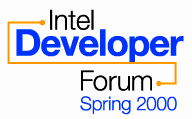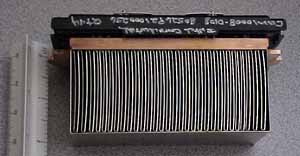Looking back at 2000 - Part 1: CPUs, Chipsets, Motherboards
by Anand Lal Shimpi on January 2, 2001 4:38 AM EST- Posted in
- CPUs
Intel Strikes Back - Spring IDF - February 2000
 On
the first day of Intel's Spring Developer Forum in Palm Springs, CA, Intel
dropped a pretty big bombshell: they had their next-generation processor core
already up and running at 1.5GHz with two of its integer units running internally
at 3.0GHz. At the time we assumed that this would give the Pentium 4, which
was then known as the Willamette, a huge advantage in business application performance.
When the Pentium 4 made its official debut however, we found that even with
its 2X clocked ALUs its integer performance was not anything to write home about.
However at the time, it put quite a bit of pressure on AMD since this chip,
which they knew very little about, was going to be the Athlon's competition
by year's end.
On
the first day of Intel's Spring Developer Forum in Palm Springs, CA, Intel
dropped a pretty big bombshell: they had their next-generation processor core
already up and running at 1.5GHz with two of its integer units running internally
at 3.0GHz. At the time we assumed that this would give the Pentium 4, which
was then known as the Willamette, a huge advantage in business application performance.
When the Pentium 4 made its official debut however, we found that even with
its 2X clocked ALUs its integer performance was not anything to write home about.
However at the time, it put quite a bit of pressure on AMD since this chip,
which they knew very little about, was going to be the Athlon's competition
by year's end.
While we were off covering the IDF, AMD was contemplating the release of the world's first 1GHz processor in order to steal some of the thunder from Intel's recent announcements. This would not only give AMD an ego boost however it would also prove to pressure Intel into what they used to be best at, engaging in price and clock speed battles. But this time around, AMD was much better prepared.
We received the phone call from AMD shortly after the announcement of Intel's 1.5GHz Willamette demonstration indicating that they were pushing ahead with the launch in less than three weeks. When we returned to the AnandTech Labs, the 1GHz Athlon was ready and waiting for us.
We were impressed with AMD's ability to ramp up the Athlon's clock speed on demand, however we were disappointed with the sacrifice each increase in clock speed seemed to yield. The off-die L2 cache of the original Athlon was hindering its performance scalability, with the core running at 1GHz the Athlon's L2 cache was stuck at 333MHz. The Athlon definitely needed an on-die L2 cache, however without any real pressure from Intel the processor could most definitely survive another three months until it would eventually gain it.
Intel's response to this was exactly what AMD was counting on, boosting the clock speed of the Pentium III from 800MHz all the way up to 1GHz. We were lucky enough to get our hands on one of very few 1GHz Pentium III engineering samples before the launch of the processor, which took place just two days after AMD's 1GHz debut. This sample was quite crude in terms of the nature of its cooling which we'll give you a quick refresher of below.
The difference between AMD's launch and Intel's that took place no more than two days later was tremendous. For the first time in quite a while, AMD's processor was going to be available, in mass quantities before Intel's. The 1GHz Athlon as well as the 900 and 950MHz parts that accompanied it would all be available by the end of the month in March. Intel however would not push for the release of their 850, 866 or 933MHz parts in spite of the fact that they had already released the 1GHz Pentium III, and even then the 1GHz Pentium III was released in "limited quantities." It wouldn't be until another quarter later that the Pentium III would be available in greater numbers.
This was truly the birth of what Intel became notorious for in Y2K, the Intel "paper-launch". It was obvious that the early release of the 1GHz Pentium III was no more than a marketing tactic, a paper-launch to say: "we have a 1GHz CPU too." It is interesting to note that just one year prior to this AMD would have been listed as the paper-launching CPU manufacturer, while it would have been unheard of that Intel would do such a thing.
Later in March, Intel released their 850 and 866MHz Pentium III processors. The launch was very quiet, for the most part because the public had already seen their 1GHz paper-launch and wasn't very interested in anything slower.











0 Comments
View All Comments